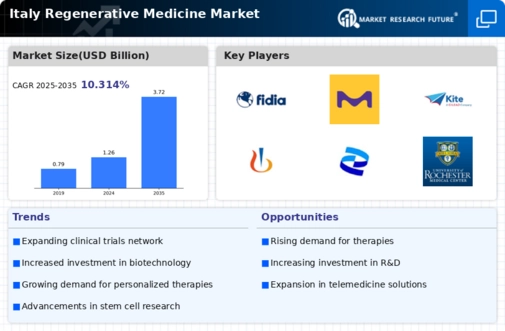Supportive Regulatory Framework
A supportive regulatory framework is emerging as a key driver for the regenerative medicine market in Italy. The Italian Medicines Agency (AIFA) has been actively working to establish guidelines that facilitate the approval and commercialization of regenerative therapies. Recent regulatory reforms aim to streamline the approval process, reducing the time it takes for innovative treatments to reach the market. This proactive approach not only encourages investment in regenerative medicine but also instills confidence among stakeholders, including researchers, manufacturers, and healthcare providers. As regulatory pathways become clearer and more efficient, the regenerative medicine market is expected to expand, with an increasing number of therapies receiving market authorization. This supportive environment is likely to foster innovation and collaboration, ultimately benefiting patients in need of advanced treatment options.
Growing Awareness and Acceptance
The growing awareness and acceptance of regenerative medicine among healthcare professionals and patients in Italy is significantly influencing the market. Educational initiatives and outreach programs have been instrumental in disseminating information about the benefits and potential of regenerative therapies. Surveys indicate that approximately 70% of healthcare providers are now familiar with regenerative medicine concepts, which has led to increased referrals and patient inquiries. This heightened awareness is fostering a more favorable environment for the adoption of innovative treatments, as patients seek alternatives to traditional therapies. Additionally, as success stories emerge from clinical trials and early adopters, public confidence in regenerative medicine is likely to strengthen, further driving market growth. The regenerative medicine market is poised to expand as acceptance continues to rise, paving the way for broader implementation in clinical practice.
Investment in Research and Development
Investment in research and development (R&D) is a crucial factor driving the regenerative medicine market in Italy. The Italian government, alongside private entities, has been increasing funding for R&D initiatives aimed at advancing regenerative therapies. In recent years, R&D expenditure in the healthcare sector has seen a notable rise, with estimates suggesting an increase of over 10% annually. This financial commitment fosters innovation, enabling researchers to explore novel approaches in cell therapy, tissue engineering, and gene therapy. Furthermore, collaborations between academic institutions and biotech companies are becoming more prevalent, enhancing the translation of scientific discoveries into clinical applications. As a result, the regenerative medicine market is likely to benefit from a robust pipeline of new therapies, addressing unmet medical needs and improving patient care.
Increasing Prevalence of Chronic Diseases
The rising incidence of chronic diseases in Italy is a pivotal driver for the regenerative medicine market. Conditions such as diabetes, cardiovascular diseases, and neurodegenerative disorders are becoming more prevalent, necessitating innovative treatment solutions. According to recent data, chronic diseases account for approximately 80% of healthcare costs in Italy, highlighting the urgent need for effective therapies. Regenerative medicine offers potential breakthroughs in treating these conditions by focusing on repairing or replacing damaged tissues and organs. This shift towards regenerative therapies is likely to reshape treatment paradigms, as healthcare providers seek to improve patient outcomes and reduce long-term costs associated with chronic disease management. As the population ages, the demand for regenerative solutions is expected to grow, further propelling the market forward.
Advancements in Manufacturing Technologies
Advancements in manufacturing technologies are playing a vital role in shaping the regenerative medicine market in Italy. Innovations in bioprinting, cell culture techniques, and scalable production methods are enhancing the feasibility of developing complex tissue constructs and cellular therapies. These technological improvements are not only reducing production costs but also increasing the quality and consistency of regenerative products. For instance, the introduction of automated bioreactors has streamlined the cell expansion process, allowing for higher yields and improved product viability. As manufacturing capabilities evolve, the regenerative medicine market is likely to witness a surge in the availability of advanced therapies, making them more accessible to healthcare providers and patients alike. This trend may lead to a more competitive landscape, as companies strive to differentiate their offerings in a rapidly growing market.





















Leave a Comment